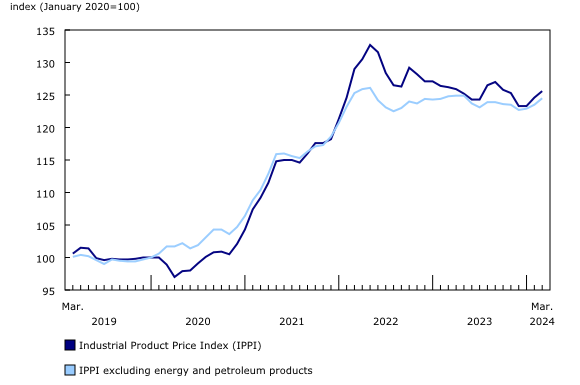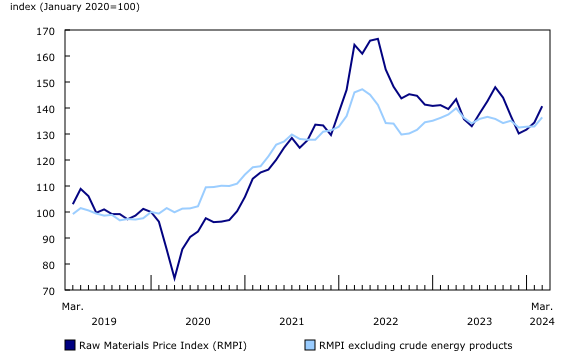Industrial product and raw materials price indexes, March 2024
Released: 2024-04-22
Prices of products manufactured in Canada, as measured by the Industrial Product Price Index (IPPI), increased 0.8% month over month in March and fell 0.5% on a yearly basis. Prices of raw materials purchased by manufacturers operating in Canada, as measured by the Raw Materials Price Index (RMPI), rose 4.7% from February to March and were up 0.8% year over year in March.
Industrial Product Price Index
The IPPI increased 0.8% month over month in March, following a 1.1% rise the previous month.
Prices for primary non-ferrous metal products rose 4.9% in March after declining for three consecutive months. This was the largest monthly increase for this commodity group since December 2022 (+7.3%). Prices were up for unwrought silver and silver alloys (+8.4%) and for unwrought gold and gold alloys (+7.1%). Precious metals rallied amid expectations that the United States Federal Reserve will make several interest rate cuts in 2024. Prices also increased for unwrought nickel and nickel alloys (+7.1%) and unwrought copper and copper alloys (+4.9%) in March.
Permitting delays have recently constrained supply growth in Indonesia, the world's top nickel producer, supporting prices in the oversupplied market. As for copper, key Chinese smelters agreed to cut production in March, while the promising interest rate outlook also exerted upward pressure as interest rates influence industrial demand for copper.
After four consecutive months of declines, prices for meat, fish and dairy products increased 3.1% in March. The increase was driven by higher prices for both fresh and frozen beef and veal (+7.8%) and fresh and frozen chicken (+16.1%). Seasonal demand started to pick up for beef while the cost of cattle remained high, mainly due to continued tight supply. According to Agriculture and Agri-Food Canada, cattle slaughter counts in March declined year over year in both Canada and the United States. Additionally, Canadian beef storage figures for the first quarter of 2024 were 15.2% lower compared with the first quarter of 2023. Chicken prices were recovering after posting five consecutive months of declines. Stronger seasonal demand played a key role in the price increases for chicken.
Lumber and other wood products experienced price growth for the third straight month in March 2024 (+3.6%), driven by higher prices for softwood lumber (+7.8%). This was the fifth consecutive monthly increase for softwood lumber and the strongest month-over-month growth since July 2023 (+11.3%). Fuelled in part by improving sentiment in the homebuilding sector as expectations rise for future interest rate cuts, demand for lumber has been strong recently, helping to push up prices.
The prices of energy and petroleum products increased 1.1% in March. Price movements for refined petroleum products were mixed. Finished motor gasoline prices increased 8.1% while diesel fuel prices fell 3.2%. For gasoline, maintenance and shutdowns at North American refineries reduced supply in March, contributing to higher prices. Additionally, the transition to more expensive summer gasoline blends and higher seasonal demand both supported the price increase. Warm weather in March reduced demand for heating fuel, which played a part in lowering diesel prices despite crude prices increasing (+7.2%). According to Natural Resources Canada, Canadian diesel refinery margins decreased by 16.9% month over month in March, dropping from 49.7 cents per litre to 41.3 cents per litre.
The prices of chemicals and chemical products rose 0.7% in March. Petrochemicals (+5.3%) contributed the most, increasing mainly due to the higher price of crude oil (+7.2%), the primary raw material input in petrochemical production.
Year over year
The IPPI declined 0.5% on a year-over-year basis in March 2024. This marks the sixth straight year-over-year decrease.
Large contributors to the decline in March include prices for unwrought nickel and nickel alloys (-25.9%), diesel fuel (-7.3%), wood pulp (-18.4%), and grain and oilseed products (-17.6%). Despite the month-over-month price increase in March 2024, nickel prices fell on a yearly basis as they declined throughout most of 2023. Nickel prices reached historic highs in 2022 and have since retreated due to generally improving supply conditions. Likewise, the declines in wood pulp and oilseed cake and meal reflect price retractions following periods of elevated prices.
Moderating the downward movement in March, prices rose year over year for unwrought gold, silver and platinum group metals, and their alloys (+8.8%); softwood lumber (+10.2%); light-duty trucks, vans and sport utility vehicles (+1.7%); and fresh and frozen beef and veal (+6.6%).
Raw Materials Price Index
In March, the RMPI rose 4.7% on a monthly basis, the largest monthly increase since March 2022 (+11.8%).
Prices for crude energy products (+8.1%) have been rising for three months in a row, leading the increase in the RMPI. Conventional crude oil prices were up 7.2% and synthetic crude oil rose 13.3%. The higher prices for crude oil were partly influenced by several OPEC+ countries extending voluntary output cuts of 2.2 million barrels per day until the end of June to stabilize the oil market. Recent attacks on major Russian refineries by Ukraine, as well as the conflict in the Middle East, also drove up crude oil prices in March.
Metal ores, concentrates and scrap rose 4.3% in March, the largest month-over-month increase since December 2022 (+6.9%). Higher prices for the group in March 2024 were driven mainly by gold, silver, and platinum group metal ores and concentrates (+8.1%). Nickel ores and concentrates (+7.0%) also rose relative to February. On the contrary, iron ores and concentrates (-11.5%) fell for the third consecutive month in March, mostly influenced in the month by slowing demand and strong supplies that led to rising inventories in the Chinese market, putting downward pressure on prices.
Animals and animal products increased 2.2% in March, mainly on higher prices for cattle and calves (+5.4%) and hogs (+6.0%). Hog prices have been increasing for three consecutive months, partly due to stronger demand in both Canada and the United States. According to Statistics Canada exports data on a customs basis, the total value of live swine exports to the United States rose 18.9% on a monthly basis in February and was 14.8% higher compared with February 2023.
Crop products rose 1.1% in March 2024, posting the first monthly increase since July 2023. Canola rebounded 5.5% in March 2024 after posting seven consecutive monthly decreases. The price of canola was up mainly due to increased export demand and lower projected domestic supply. The seeded area intended for canola production in Canada is projected to drop 3.1% in 2024 on a yearly basis.
Year over year
The RMPI was up 0.8% year over year in March, the first year-over-year increase since September 2023. Excluding crude energy products, the RMPI fell 0.8% in March 2024.
Conventional crude oil (+7.1%) was the biggest driver of the upward movement in the RMPI. Gold, silver, and platinum group metal ores and concentrates (+15.5%), cattle and calves (+15.8%), and synthetic crude oil (+5.0%) were other key upward contributors.
Major downward contributors to the RMPI on a year-over-year basis include nickel ores and concentrates (-25.9%) and canola (-21.8%).
Did you know we have a mobile app?
Download our mobile app and get timely access to data at your fingertips! The StatsCAN app is available for free on the App Store and on Google Play.
Note to readers
The Industrial Product Price Index (IPPI) and the Raw Materials Price Index (RMPI) are available at the Canada level only. Selected commodity groups within the IPPI are also available by region.
With each release, data for the previous six months may have been revised. The indexes are not seasonally adjusted.
The IPPI reflects the prices that producers in Canada receive as goods leave the plant gate. The IPPI does not reflect what the consumer pays. Unlike the Consumer Price Index, the IPPI excludes indirect taxes and all costs that occur between the time a good leaves the plant and the time the final user takes possession of the good. This includes transportation, wholesale and retail costs.
Canadian producers export many goods. Canadian producers often indicate goods' prices in foreign currencies, especially in US dollars, which are then converted into Canadian dollars. This is particularly the case for motor vehicles, pulp and paper products, and wood products. Therefore, fluctuations in the value of the Canadian dollar against its US counterpart affect the IPPI. However, the conversion to Canadian dollars reflects only how respondents provide their prices. This is not a measure that takes into account the full effect of exchange rates.
The conversion of prices received in US dollars is based on the average monthly exchange rate established by the Bank of Canada and available in Table 33-10-0163-01 (series v111666275). Monthly and annual variations in the exchange rate, as described in the release, are calculated according to the indirect quotation of the exchange rate (for example, CAN$1 = US$X).
The RMPI reflects the prices paid by Canadian manufacturers for key raw materials. Many of those prices are set on the world market. However, as few prices are denominated in foreign currencies, their conversion into Canadian dollars has only a minor effect on the calculation of the RMPI.
Products
Statistics Canada launched the Producer Price Indexes Portal as part of a suite of portals for prices and price indexes. This webpage provides Canadians with a single point of access to a variety of statistics and measures related to producer prices.
The video "Producer price indexes" is available on the Statistics Canada Training Institute webpage. It introduces Statistics Canada's producer price indexes: what they are, how they are made and what they are used for.
Next release
The industrial product and raw materials price indexes for April will be released on May 28.
Contact information
For more information, or to enquire about the concepts, methods or data quality of this release, contact us (toll-free 1-800-263-1136; 514-283-8300; infostats@statcan.gc.ca) or Media Relations (statcan.mediahotline-ligneinfomedias.statcan@statcan.gc.ca).
- Date modified:



